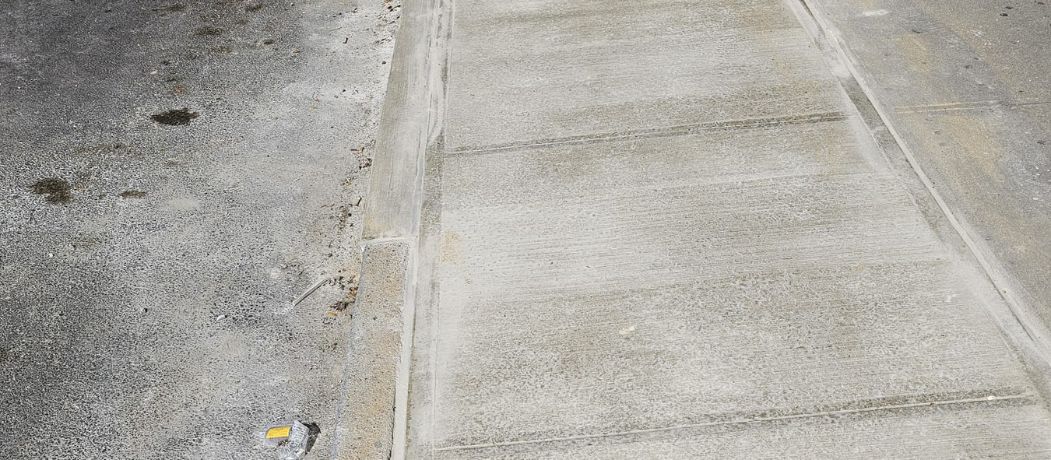
Why You Should Not Ignore Small Cracks in Sidewalks
Small cracks may look harmless, but they almost always grow into bigger problems. As a property owner, ignoring them can mean heavy fines, liability for injuries, or even repair bills from the city if you miss the 75-day deadline to fix them. These cracks aren’t just cosmetic flaws, they’re early warning signs of safety hazards, legal risks, and costly repairs.
Below are key reasons why even the smallest sidewalk cracks should never be ignored.
Small Cracks Grow into Big Problems
Sidewalk cracks rarely stay the same size. Changes in temperature cause concrete to naturally expand and contract. Small cracks in the concrete create weak spots where more damage can spread. It gets wet from the rain, tree roots push up, and people walking on it all the time makes the problem worse. Over time, what once looked like a harmless hairline fracture can become a large uneven gap, needing not just a patch but an entire replacement of the affected slab.
Addressing small cracks early is far less expensive than waiting until the damage requires a full-scale repair or replacement. Think of it as preventive maintenance: a quick, affordable fix today can save you thousands tomorrow.
Safety Hazards and Trip Risks
One of the most serious consequences of sidewalk cracks is the risk they pose to pedestrians. Even small cracks can create uneven surfaces that catch shoes, wheels, or canes. For children, elderly individuals, and people with mobility challenges, these minor hazards can lead to serious injuries from slips, trips, or falls.
If someone gets hurt because of a sidewalk defect on your property, you could be held legally responsible. Medical costs, legal fees, and liability claims can quickly add up, which is far more than the cost of fixing the crack in the first place. Simply put, ignoring cracks is not just a risk to your sidewalk; it’s a risk to people’s safety.
Water Damage and Foundation Erosion
Cracks may look small on the surface, but they open the door to one of concrete’s biggest enemies-water. When water gets through the cracks and down to the sidewalk's base, it makes the foundation less stable. During colder months, this problem gets worse due to the freeze-thaw cycle. Water freezes, expands, and forces the crack wider, making the sidewalk deteriorate faster.
Over time, this hidden damage leads to hollow spots, sinking slabs, and widespread erosion. By the time the problem becomes visible, it’s often too late for simple repairs.
DOT Violations and Costly Fines
In cities like New York, property owners are legally responsible for maintaining sidewalks adjacent to their properties. The Department of Transportation (DOT) regularly inspects sidewalks, and even small cracks can trigger a violation notice under the NYC Administrative Code.
Getting a violation means you have to fix the sidewalk within a certain amount of time. If you fail to do so, the city will hire its own contractor to perform the work, and send you the bill, often at a much higher cost than if you had handled the repairs yourself. Additionally, you may face fines that add financial strain to an already expensive problem.
Protecting Property Value and Curb Appeal
First impressions matter. Cracked sidewalks can make your property look like it hasn't been taken care of in a while. For homeowners, this lowers curb appeal, which directly impacts property value. For businesses, a cracked sidewalk sends the wrong message to customers, making your establishment appear unsafe or unprofessional.
On the other hand, a smooth, well-maintained sidewalk enhances your property’s overall appearance and communicates responsibility, safety, and care.
Saving Money in the Long Run
It may feel tempting to delay sidewalk repairs, but postponing them only multiplies the costs. A small crack can usually be repaired with simple sealing or patching, which is relatively inexpensive. Left unattended, however, the same crack can lead to foundation problems, slab replacements, legal liability, and city fines.
In almost every case, repairing cracks early is the most cost-effective option. It’s not just about spending money on repairs, as it’s about avoiding the much higher costs of neglect.
Final Thoughts
Small cracks in sidewalks may not seem like an urgent problem, but they are early warning signs of bigger issues ahead. Ignoring them comes with the risk of turning a manageable repair into a costly replacement, creates safety hazards for pedestrians, exposes you to legal liability, and can even result in city violations and fines.
By addressing sidewalk cracks as soon as they appear, you’re protecting your property, your finances, and the people who use your sidewalk every day. The bottom line is simple: small cracks should never be ignored, fix them today with sidewalk contractors to avoid major problems tomorrow.